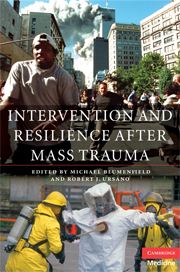Book contents
- Frontmatter
- Contents
- List of contributors
- Foreword by Joseph T. English
- Preface
- 1 Systems, science, and populations: Effective early mental health intervention following mass trauma: the roles of government, clinicians, and communities
- 2 Factors in the development of community resilience to disasters
- 3 Psychological first aid
- 4 Acute stress disorder and early interventions after trauma
- 5 The role of pharmacotherapy in early interventions
- 6 Should culture considerations influence early intervention?
- 7 Resilience is the default: how not to miss it
- 8 Epilog: Early intervention for individuals and communities: planning for the future while meeting present needs
- Index
- References
2 - Factors in the development of community resilience to disasters
- Frontmatter
- Contents
- List of contributors
- Foreword by Joseph T. English
- Preface
- 1 Systems, science, and populations: Effective early mental health intervention following mass trauma: the roles of government, clinicians, and communities
- 2 Factors in the development of community resilience to disasters
- 3 Psychological first aid
- 4 Acute stress disorder and early interventions after trauma
- 5 The role of pharmacotherapy in early interventions
- 6 Should culture considerations influence early intervention?
- 7 Resilience is the default: how not to miss it
- 8 Epilog: Early intervention for individuals and communities: planning for the future while meeting present needs
- Index
- References
Summary
Introduction
Terrorist incidents and severe natural disasters have focused concern on preparedness and response activities to enhance psychological and social adjustment in the aftermath of extreme events and to minimize maladaptation over time. Borrowing from a growing body of work describing the characteristics that promote resilience in individuals, the concept of community resilience has emerged as a community-level construct to foster individual, family, and community adaptation. The likelihood of unanticipated terrorist events and the possibility of massive infrastructure destruction associated with major disasters increase the importance of community resilience strategies.
Relatively little is known about what constitutes a resilient community or about the factors, conditions, and processes that promote it. In this paper, we (1) describe the construct of community resilience in the context of disasters, (2) propose a set of contributing factors, (3) identify potential barriers, and (4) make recommendations for enhancing community resilience. The paper does not constitute a formal review of the literature on community resilience.
Definitions
A discussion of community resilience requires consensus in our understanding of several key terms including “community,” “disaster,” and “resilience.”
Community
The notion of community has been widely discussed in both the social science and health literatures (Cohen, 2003; Institute of Medicine, 2003; Jewkes and Murcott, 1996). Depending on context, a variety of conceptualizations and components have been described. Traditionally, a community refers to people, organizations, structures, and systems in close geographic proximity and with physical boundaries and borders (e.g., a town).
- Type
- Chapter
- Information
- Intervention and Resilience after Mass Trauma , pp. 49 - 68Publisher: Cambridge University PressPrint publication year: 2000
References
- 14
- Cited by



